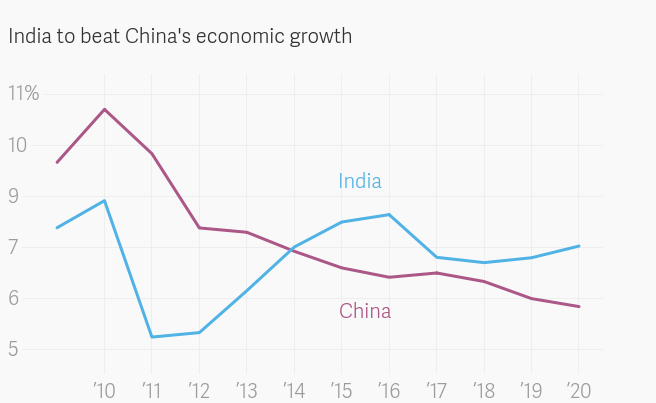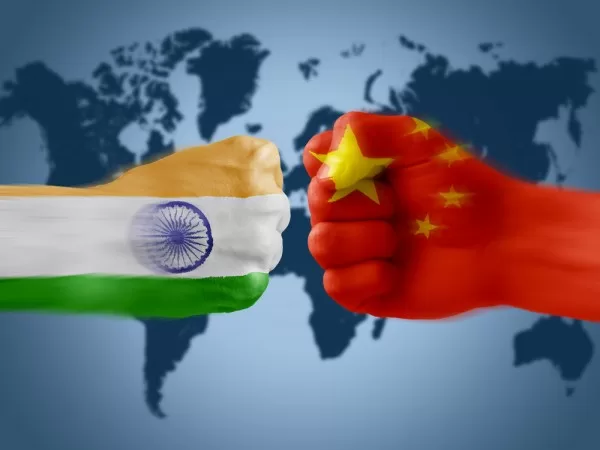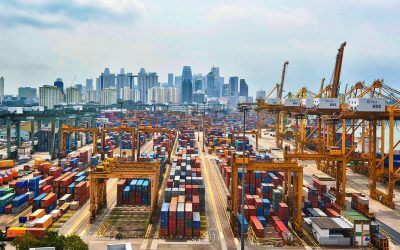It’s the battle of India vs. China! Which is better for investors?
China and India are the two most populous nations on the planet, and are very similar in some ways. They’re both emerging markets with high growth rates usually exceeding 6%.
Up until the late 1800s, India and China were also the world’s two biggest economies. Places like Japan and the United States only surpassed them within the last century.
Yet when it comes to economic development, China and India are a world apart.
China jolted forward ever since their reform policies during the 1980s and 1990s. A main reason was privatization of state-owned businesses, which drew foreign investment and created huge amounts of local wealth.
Meanwhile, India lagged behind over the past several decades. Rampant corruption, seemingly endless bureaucracy, inept politicians, lack of a clear legal structure, and other challenges held the country back… and still do.
Is India Growing Faster Than China?
Even Beijing has shown public concern. That’s something notable for the Chinese government which is often secretive about large problems.
Perhaps the most important issue in China is corruption. Senior officials in Beijing have vowed to tackle corruption while some of the largest companies in China, like Sinopec, have been publicly called out and told to clean up their act.
In particular, Premier Li is showing the fight against corruption is among his government’s top focuses. He says China will show “zero-tolerance” for corrupt executives and communist party officials regardless of “how senior their position is”.
The Chinese economy loses an estimated US$100 billion every year because of corruption.
Furthermore, rising wages are causing weaker export growth, fixed-asset investment is near a 15-year low, property bubble concerns are worrying economists, and lending data from banks remain poor – just to name a few more issues.

A graph showing India’s historical GDP growth versus China’s. For the past decade, India has outperformed in this regard.
The Indian Century
Thankfully, India’s economy is now picking up steam and could have the ability to drive global growth well into the future.
India’s recent GDP growth rate has already surpassed China’s. But it won’t stop there. Projections by CEBR claim India will become the world’s third largest economy by 2030. M
Several top experts even say India will become the world’s largest economy in the long-term as China faces a demographic shift and the US declines in prominence.
Yet foreign investors only recently started having a positive outlook toward the Indian economy.
Prime Minister Narendra Modi was elected in 2014 and initiated quick measures aimed at increasing competitiveness and improving India’s infrastructure.
Arguably, these type of economic reforms in India will make all the difference. China supports entrepreneurship and international investment for several decades. India consistently lags behind though.
High-tax rates, bureaucracy, and lack of government support for SMEs stifles wealth creation in India. Similarly, public schooling is notoriously bad while education is not mandatory. This has led to an uneducated workforce and a literacy rate of just 74%.
In short, leadership determined to spearhead much needed policies is what China had during the late 80s and early 90s, but is something India only enjoyed since 2014.
Now that India has a seemingly committed government, the 21st century looks bright for the world’s largest democracy.
India vs. China: What’s a Better Investment?
While China may be facing a “slowdown”, they’re still among the top emerging markets in terms of GDP growth.
From 1979 until 2010, the average GDP growth rate in China was 9.9%. While nobody can expect figures in the upper single digits in China anymore, most other nations would give practically anything for even 6%.
Likewise, investing in India is attractive to companies and investors due to reasons we already explained.
It’s hard to determine whether Chinese stocks or their Indian counterparts will perform better over the short, medium, or long-term. We recommend that investors have sufficient exposure to each market within an already diversified portfolio.
Why should there be an India vs. China when you can easily invest in both countries?
China vs. India: Frequently Asked Questions
Does India or China Have a Bigger Population?
India has the world's largest population with over 1.41 billion inhabitants and rising.
Back in April 2023, India's population officially surpassed that of China's.
While China will soon face demographic decline, India's population is set to continue rising until later this century.
How Big is India Compared to China?
While India is a larger country in terms of population, the China's size of economy is several times larger compared to India's.
Does China Have a Larger Economy Than India?
With a GDP above $18 billion, the size of China's economy is significantly larger than India's.
In fact, the GDP of India is still below $4 billion. China's economy is over four times bigger despite India's population.







